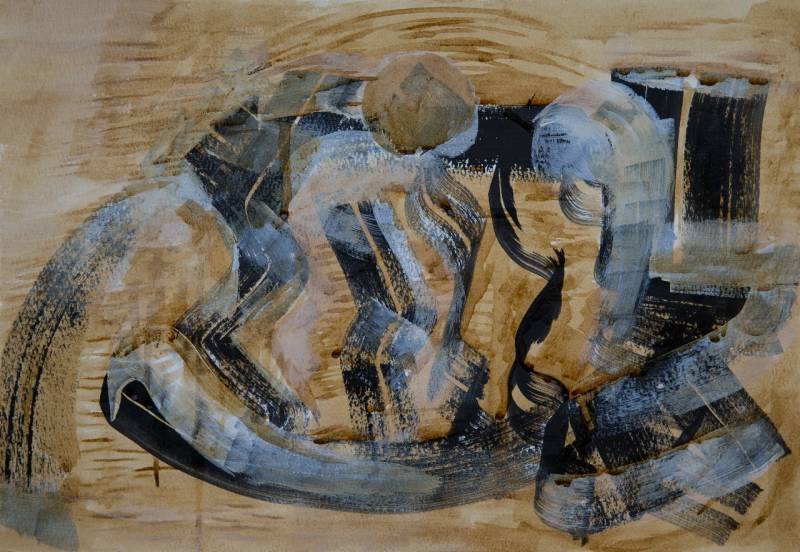
Have you ever been in that state of lucid dreaming where what you are experiencing in your dream feels almost as real as any reality, yet you cannot move? That state between alertness and hallucination. Somewhere in your consciousness you are aware you are dreaming, yet you give in and let that state take you places. Standing before Salman Imam’s paintings is like stepping into a realm where the boundaries of consciousness blur, evoking the liminality of lucid dreaming. His work captures that in-between state—where reality and imagination intertwine, where clarity gives way to abstraction, and where the mind surrenders to the vast unknown. In this suspended moment, Imam's canvases take on a role beyond mere visual representation; they become portals into the psyche, inviting viewers to explore their innermost landscapes.
Imam’s own statement resonates deeply with Carl Jung’s idea of the shadow self—the repressed aspects of our psyche that remain hidden beneath layers of social conditioning and logical reasoning. Jung believed that true self-awareness emerges when we confront this shadow and transcend the constraints of the conscious mind. Similarly, Imam challenges the mind’s deceptive nature, as he describes it, revealing how it distorts reality and inhibits our capacity for beauty and transcendence.
Freud’s exploration of dreams as the “royal road to the unconscious” also aligns with the dreamlike quality of Imam’s paintings. Freud saw dreams as a medium for the mind to process repressed desires and fears through symbolic imagery, and Imam’s work evokes this symbolic language. His paintings eschew logical understanding, much like dreams, offering instead a visceral, affective experience that taps into the unconscious. The narratives in his works are deliberately unresolved, reflecting the infinite complexity of the psyche and the divine.
Imam’s work shares affinities with Abstract Expressionism in its attempt to convey raw emotion and spiritual truths beyond the confines of form. Imam’s canvases asks viewers to engage with their emotional resonance rather than any literal interpretation. His belief that the mind creates limitations aligns with the Expressionist ethos of liberating the artist and viewer from traditional aesthetic constraints.

At the same time, his work recalls the dreamlike, otherworldly quality of Surrealism. Imam crafts a space where reality bends and dissolves, challenging the viewer to embrace uncertainty. However, where Surrealism often juxtaposes incongruent elements to provoke shock or amusement, Imam’s approach feels meditative, almost spiritual, rooted in a desire to uplift and expand the viewer’s perception.
In a world increasingly driven by rationality and productivity, Salman Imam’s work stands as a quiet rebellion—a reminder of the untapped beauty and vastness within us all
True to its title, his painting, "Enigma" resonates with the artist’s idea of the mind as a deceiver. The intricate shapes refuse to give a singular meaning, reflecting how the mind complicates reality, distorting perceptions. The painting embodies that liminal state where one teeters between understanding and surrender—much like the elusive moment between wakefulness and dreaming. It compels the viewer to let go of logical interpretation and allow intuition to guide their emotional experience.

Standing before "Enigma," the viewer may feel a subtle pull into its quiet chaos—a sensation similar to navigating complex thoughts or emotions without resolution. The earthy tones add a grounding element, while the composition suggests that answers exist beyond comprehension.
Imam’s assertion that the mind loses interest in what it can quickly understand is an incisive observation. His paintings resist easy interpretation, much like the infinite narratives of abstract or non-linear art. The intricate layering of forms, textures, and colors in his work speaks to the vastness of human experience. It echoes his desire to liberate his audience from the tyranny of rationality and encourage them to simply feel.

"Joy" bursts with vibrancy and energy, contrasting sharply with the earthy tones of "Enigma." This painting aligns with the artist’s desire to create works that inspire feeling rather than logical understanding. The dynamic composition mirrors the untamed potential within the human spirit—layers of beauty waiting to emerge. "Joy" rejects rigid definitions, much like Salman Imam’s rejection of the mind’s limiting framework. Instead, it celebrates freedom and raw emotional release. It reminds the viewer of the pure, childlike state of wonder where beauty is felt, not analysed. "Joy" draws viewers into a sensory experience. Its liveliness invites them to connect with their own spontaneity and uninhibited feelings. The radiant colors and chaotic harmony act as a reminder of the beauty found in unstructured, intuitive moments.
The tangible and dynamic nature of his compositions seems to embody the tension between containment and release, between the structure imposed by the mind and the freedom of the divine. This interplay creates a kind of visual paradox, compelling viewers to oscillate between recognition and abstraction, ultimately leading them to surrender to the indefinable.
The "Travel" series comprises four abstract compositions unified by a warm, sepia-toned palette created with coffee and acrylic. Each piece combines gestural brush strokes, overlapping forms, and textural variations. Despite their abstract nature, the recurring lines, arcs, and rhythmic patterns suggest a narrative or movement—like the trails one leaves behind during a journey. As suggested by its title, "Travel" appears to be both a literal and metaphorical exploration. Each piece can represent a phase in a personal or emotional journey—fragmented yet connected. The earthy medium of coffee adds a tactile and temporal quality, alluding to the passage of time. The abstract forms reflect Salman Imam’s belief that journeys (whether mental, emotional, or spiritual) are not to be "understood" but experienced. The viewer might feel as though they are traversing different landscapes or states of mind while observing this series. The repeated patterns and organic forms convey a sense of movement and continuity—echoing the concept of a never-ending story.

Salman Imam's technique is a fascinating interplay of constraint and dynamism, embodying the energy of action painting on a surprisingly intimate scale. He deliberately works on small surfaces, compressing expansive, beyond-life notions into confined spaces. This choice creates an intense visual tension, as the viewer is drawn into the microcosm of his gestural brushstrokes and layered compositions. His color palette operates on two extreme poles: subdued, earthy tones that evoke a sense of grounding and connection to nature, contrasted with vibrant neon hues that pulse with an almost otherworldly energy. This duality mirrors the themes of his work—between the logical mind and the boundless divine—capturing a delicate balance between restraint and liberation.
In a world increasingly driven by rationality and productivity, Salman Imam’s work stands as a quiet rebellion—a reminder of the untapped beauty and vastness within us all. Through his paintings, he offers viewers not just stories that never end but journeys into the infinite potential of their own being.
Experiencing Imam’s art is akin to lingering in that liminal state of lucid dreaming, where logic momentarily relinquishes control and the subconscious takes over. His paintings don’t demand to be analysed; they invite submission; a letting go of the very capacities that typically govern our understanding. It is in this surrender that the transformative power of his art lies.

Salman Imam, a self-taught artist from Karachi, combines his passions for photography, painting, music, and aquascaping to celebrate nature’s beauty and the complexity of human emotions. Formerly a professional pilot, he transitioned to the arts, becoming an award-winning photographer for Getty Images and Istock Images. His meditative approach to painting seeks to evoke joy, introspection, and a deeper connection with life’s profound mysteries, reflecting his belief in art as both a spiritual and creative practice.
These works of Salman Imam were part of a three-person show titled “Echoes of the infinity”, held at Numaishgah Gallery from December 1 to December 10 2024.

